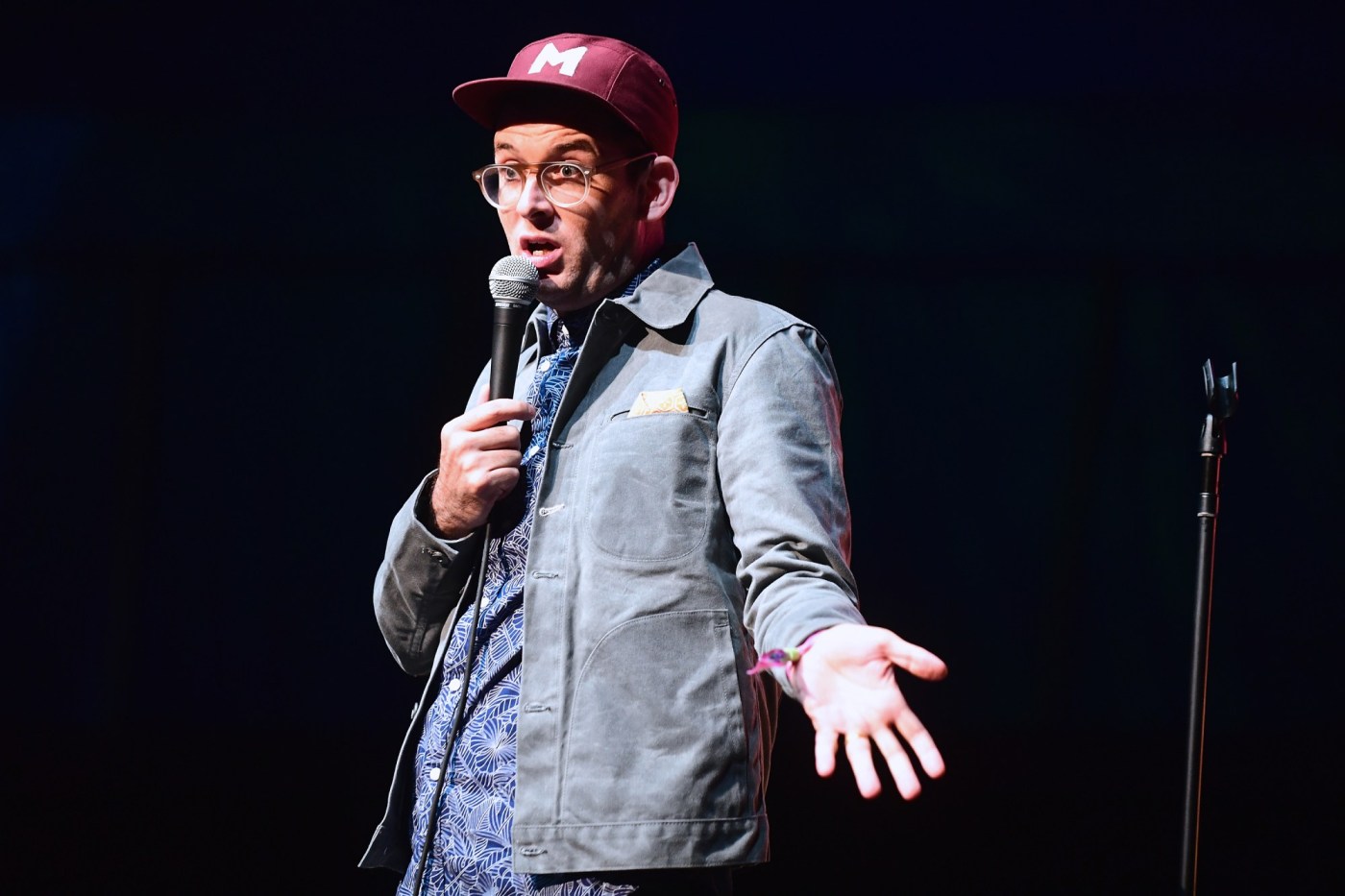
Whereya from? Whaddaya do for a living? Comic Moshe Kasher and the art of crowd work
About five minutes into Moshe Kasher’s first set at the Den Theatre on Saturday, he assured the audience, “I’ll do some material eventually.” He said it with a bit of self-deprecation. At that moment, and from the second he stepped on stage, he was having too much fun talking to the audience, listening closely to what they said, getting to know who sat at his feet and on the periphery of the stage, in the shadows. Who was there, at that show? A woman who ran “a Jewish-themed OnlyFans account.” A woman with a sexual thing for Jewish comics who, though she herself was not Jewish, had a tattoo of the mouse from Art Spiegelman’s Holocaust classic “Maus.” Also, a man who specializes in providing insurance to cannabis dispensaries.
And a man who almost drowned off Crete, a woman who worked as a therapist and a guy seated directly in front of Kasher whose burly appearance suggested he rocked. Kasher asked: “Do you rock?” The man nodded. How much do you rock, Kasher asked. “Very,” the man replied.
Seated to his right, coincidentally, was a man who sang in a metal band.
How do I know this, and why am I telling you?
Because Kasher has perfected one of the most controversial aspects of contemporary stand-up comedy: Crowd work. In Chicago, we call this improvisation. We claim it as a local export. Stand-up comedy, though, has long held a love/hate with audience banter. Not Kasher. He’s been making crowd work the centerpiece of his act for two decades. In fact, you might say it’s too bad that Kasher, who grew up in San Francisco (and is married to another comedian, Rockford native Natasha Leggero), isn’t a Chicagoan: He formalized the crowd-work aspect of stand-up comedy, and last weekend was exhibit A.
At the beginning of the show, he dragged out an actual “Wheel of Crowd Work,” which he spun throughout his set, giving audience prompts — job, family, fantasy, tattoos. He said he would mine actual experiences, but that the enemy of this approach is silence.
If you haven’t seen any live stand-up comedy in a while, you might be surprised to find the old ratio of audience banter-to-prepared material veering these days in the direction of spontaneous crowd conversation. Crowd work — Where ya’ from? Whatcha do? Is that your date? — is particularly ubiquitous across the social media accounts of comics on Instagram and TikTok, where short clips of them having once-in-a-lifetime chats with fans (or shutting down hecklers) have helped many an unknown comic go viral. (Most famously, in the past couple of years, Ohio stand-up Matt Rife went from who? to playing arenas, on the popularity of such spontaneity; he’s doing eight shows at the Chicago Theatre in December.) Though like everything, there’s smart crowd work and lazy crowd work, and when Kasher takes time to explain the pros and cons of what generations of comics still consider filler, it comes off like a light provocation.
An intentional rewriting of rules.
Indeed, in Kasher’s excellent new memoir, “Subculture Vulture,” he talks about older comics berating him when he was starting out, saying he was too loose onstage, too reliant on the crowd, not the written material. But he’s come to recognize a truism about his profession: The image of a stand-up as a truth teller is something many comics convince themselves of “out of an insecurity about the value of our work.” So he decided to “use the writing I had to allow me to go wherever I wanted onstage.” Soon: “The better the show, the more fun I’m having, the less written jokes” he was telling.
Watching Kasher do crowd work at the Den, it played like an argument for the need for comics to live in the moment — for stand-up comedy to return to being there. He would find a thread in someone’s story to stretch it cleverly into written material. A mention of gun ownership became a (written) joke about the only two types of people this election season: “People who say they’re voting for Kamala and ‘That’s a very private decision.’” A badly rendered tattoo became a long bit about no less than the meaning of existence.
But you could also hear the detractors of crowd work, the complaints that the popularity of the technique leads to more comics trying to engineer the unpredictable. Or worse: It leads to junk comedy, people crowding stages who think they are funny but don’t have the patience to write. Asked what makes a stand-up comic, detractors of crowd work might say the foundation of the job is writing material, honing it, failing, improving. It’s easy to picture Jerry Seinfeld, with 90 minutes of material chiseled out of hundreds of hours of stand-up. If you’ve ever seen him live, he reacts to crowd banter with a chilly detachment, as if an audience member were knocking on the window of his vintage Porsche.
But crowd banter is nothing new, of course.
Robin Williams did it well. Don Rickles, of course. Patrice O’Neal. Todd Barry centered an entire tour around conversations with audiences. The night before Kasher played Wicker Park, Chicago native Conner O’Malley played the Vic, closing with a bit about active-shooter drills that required audience members to participate. Steve Martin — back in his wild-and-crazy days — once took an entire audience out of a nightclub, led them down the street to McDonald’s and ordered 274 cheeseburgers, then changed that to one order of fries.
There’s no right or wrong approach to an audience.
There’s just funny and dumb, and though Chicago comedy clubs are full of comics right now who want to know what you do for a living and if that’s your spouse, it takes a special comic to listen closely. Kasher listens better than most comedians, then asks thoughtful follow-up questions that somehow remind the audience of just how random the world, seated all around them, can look. It’s a deeply humanist approach to comedy.
With one problem: I live in fear of comedians pointing to me at a stand-up show, and the more comics rely on crowd work, the better the chances that someday I will get noticed.
Better to sit at the back.
cborrelli@chicagotribune.com


